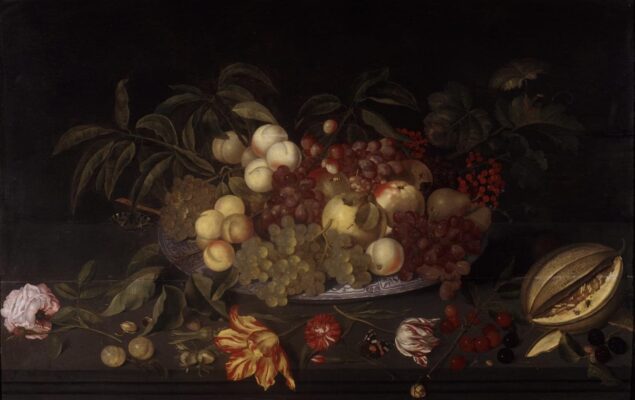The Dutch Restitutions Committee has assessed an application for restitution of the painting Fruit Still Life by Johannes Bosschaert (act. ca. 1606–1628), son of Ambrosius Bosschaert I. The painting is part of the Netherlands Art Property Collection (NK Collection, inv. no. 2856), which consists of artworks returned to the Netherlands after the Second World War. The application was submitted in 2022 by the Order of Freemasons under the Grand Orient of the Netherlands. The Committee has now advised the Dutch Minister of Education, Culture and Science to restitute the painting to the applicants.
According to new research, the painting can be seen on a 1938 group photograph of the Order’s main board. Additional photographic material supports the conclusion that the photograph was taken in the lodge in Fluwelen Burgwal in The Hague. The investigation was conducted by the Expert Centre Restitution (ECR) of the NIOD Institute for War, Holocaust and Genocide Studies, making use of research done by the art historian Dr. Andrea Kroon.

Johannes Bosschaert (act. ca. 1606–1628), Fruit Still Life, ca. 1625-26
Rijksdienst voor het Cultureel Erfgoed, Amersfoort
The Order was banned during the occupation by the German occupying forces, and its property was liquidated under duress. In June 1944 the painting was sold to the Dutch civil servant Dr Erhard Göpel for Sonderauftrag Linz (Special Mission Linz), an organization dedicated to acquiring works of art for the planned Führer Museum in Linz, after being photographed in May 1944. In the visual documentation of paintings photographed at the same time, the provenance is listed as “coll. Arntzenius.”
Willem Nicolaas Arntzenius was a curator for the Order from 1925 and after the war he played a key role in attempts by the Order to recover its property. There is correspondence in his handwriting in the Order’s post-war documentation. Although the painting is not separately referred to, several sources reveal that during the occupation Arntzenius took works of art from the lodge to a place of safety.
The painting was brought back from Germany after the war and included in the NK Collection. The Order did not make a separate declaration to the Netherlands Art Property Foundation (SNK) about it being missing. The painting’s provenance is noted in SNK documentation as ‘Arntzenius collection, The Hague’. In view of the above, among other things, the Committee saw no reason to assume that the painting belonged to Arntzenius personally.
On the basis of the investigation, the Committee deemed it highly likely that the painting was the property of the Order of Freemasons. The Committee also considered it sufficiently plausible that the Order lost possession of the painting involuntarily as a result of circumstances directly connected with the Nazi regime.
The full report is available on the Restitutions Committee’s website.
